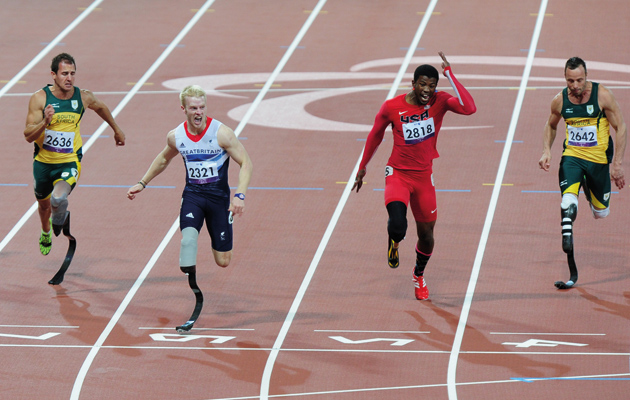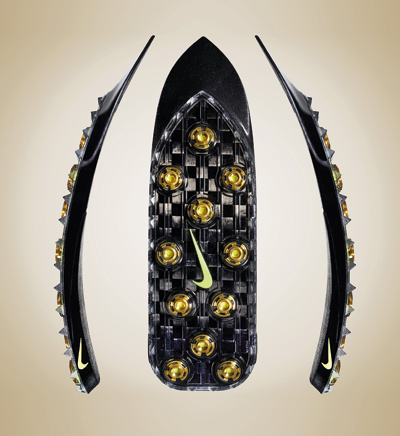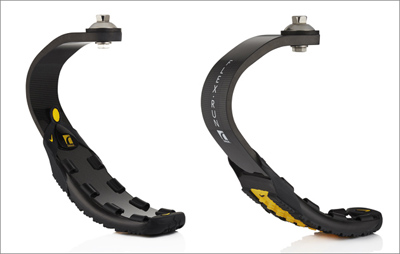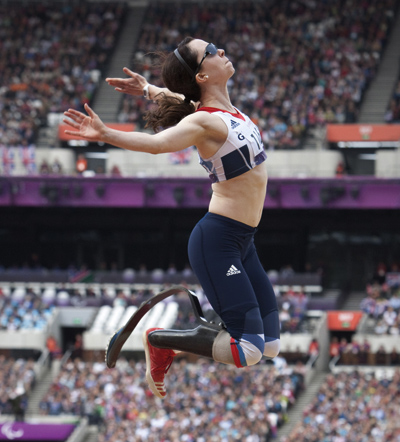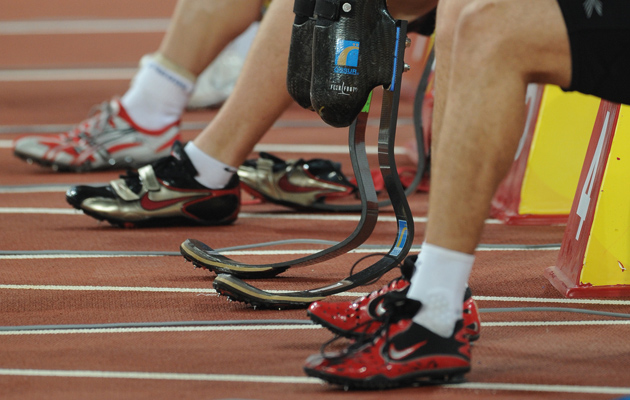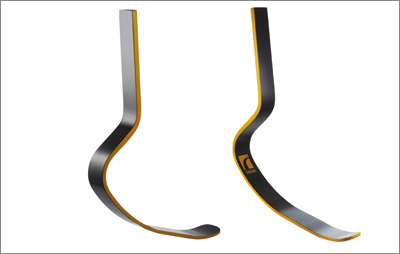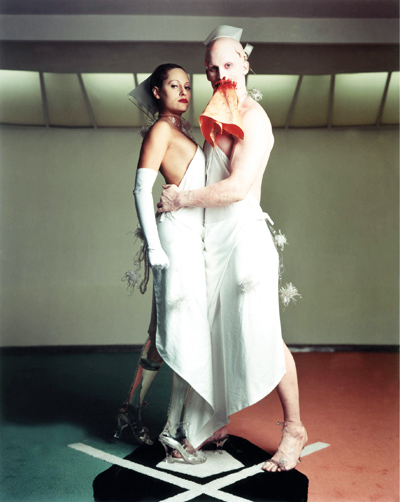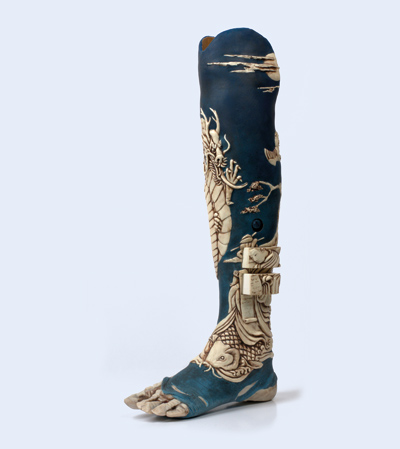|
|
||
|
The carbon-fibre blades worn by Paralympic athletes have changed people’s expectations of prostheses. But they also raise difficult questions about how the design of artificial limbs can constrict the user’s identity If any object could be said to embody the Paralympics, perhaps it is the carbon-fibre Flex-Foot running blade, which is most striking when worn with Nike’s gold spikes. On these, athletes such as Jonnie Peacock and Richard Whitehead have propelled themselves to gold medals in the 100m and 200m, with Peacock wearing below-knee and Whitehead above-knee prostheses. The abstract sculptural form of running blades challenges the notion that a prosthetic limb has to be a facsimile of a human limb. In prosthetic hands, there has long been a distinction between “cosmetic hands” moulded from silicon to imitate human skin, right down to wrinkles and pores, and hooks. The latter are designed as tools, and seen as such. Yet somewhere in the equations that determine the structure and dynamics of blades, a sense of beauty lies; as in the profile of an airline wing or the cables of a suspension bridge that owe little to aesthetic considerations, a strong aesthetic nonetheless emerges. There is also an interesting dialogue between the forms of the blade and the wearer’s body. Even when they are static, they suggest the potential for movement.
The Nike Spike Pad for Össur’s Cheetah running blades Flex-Foot blades are made in Reykjavík, which seems an unlikely place to find the pioneers in this field; Iceland has not yet won an Olympic track medal. Yet in 1970s Iceland, poor working conditions in commercial fishing resulted in significant numbers of industrial accidents and limb loss in healthy young men. This – and a well-financed healthcare system – created a distinctive domestic market for Össur, the company founded in 1971 by the prosthetist and inventor Össur Kristinsson. Meanwhile, in the United States, the number of disabled Vietnam war veterans was driving advances in sports wheelchair design and the growth of the disability rights movement. In 1984, American medical engineer Van Phillips founded the artificial limb manufacturer Flex-Foot Inc, which was bought by Össur in 2000.
Flex-Run blades by Össur The history of prostheses is as much a history of the materials used to make them. In the 1904 St Louis games, the gymnast George Eyser won six Olympic medals, including gold in the vault, parallel bars and rope-climbing, with a wooden leg. Aluminium was later adopted, but it was the search for a lighter and stronger alternative to both wood and aluminium in aeronautical applications that led RAF researchers to invent carbon fibre in 1963. Its subsequent non-military use in Formula 1 motor racing created an industry of independent fabricators, the small scale and craft skills of which opened up collaboration and innovation in other fields. These included sports such as cycling and tennis, as well as prosthetics, most notably sporting prosthetics. Just as Olympic heptathlete Jessica Ennes-Hill has six different pairs of shoes for her seven events, so running blades for the 100m will be subtly different to those for the 400m. Össur has a range of ten nominal thicknesses to suit different activities and body masses, and at the highest level an athlete will experiment with the manufactured tolerances.
Stef Reid competes in the women’s long jump F42/F44 at the London 2012 Paralympics Prosthetist Richard Hirons, who has worked with Paralympians, says that, until the blade is tuned for the individual athlete, it might feel “like stepping into a hole”, or “walking uphill”. Despite its sophistication, Hirons stresses that the device’s role should not be overstated, lest the athlete’s achievement be underestimated in turn. In his clinical practice, he has encountered the expectation that running blades will enable any amputee to run fast – as if the same would be true for a non-disabled person putting on Usain Bolt’s running spikes. “At the end of the day, it’s a big shoe,” he says. Nonetheless, more than a hundred years after George Eyser, the technical development of sporting prostheses has prompted questions over whether they might actually afford an unfair advantage over non-disabled athletes. The International Association of Athletics Federations has amended its rules on the use of “technical aids” during competition. Rule 144.2 prohibits the “use of any technical device that incorporates springs, wheels or any other element that provides a user with an advantage over another athlete not using such a device”, and was used to exclude Oscar Pistorius from the 2008 Olympics in Beijing – where he won Paralympic gold medals in the T44 100m, |
Words Graham Pullin
Image above: Jonnie Peacock wins gold in the men’s 100m T44 at the London 2012 Paralympics
Images: Jamie Mcdonald; Getty images; Össur; Helen Weisenhaan; Mark Ralston; AFP; Alternative Limb Project; Annie Waters; Photos 12; Alamy |
|
|
||
|
Oscar Pistorius’s blades before a men’s 100m T44 heat at the 2008 Beijing Paralympics |
||
| Eli Wolff, director of the Inclusive Sports Initiative at the Institute for Human Centered Design in Boston, has been involved in these issues for 15 years, including the drafting of provisions addressing sport within the United Nations Convention on the Rights of Persons with Disabilities. According to Wolff, “The disabled athlete is still siloed and segregated. We have come far, but still have far to go.” He would like prostheses to be more routinely approached, in the manner that advances in sporting equipment might be, whereas at present their treatment is often more reminiscent of doping and illegal body enhancement.
Wolff also thinks that opportunities are being missed for innovations that could help sport to evolve as a whole. This is a controversy familiar to Hugh Herr, who was already a brilliant rock climber when at the age of 17 he lost both his legs to frostbite. Following the accident, he designed specialist climbing prostheses with pointed feet that afforded him a toehold where other climbers could not even gain a fingerhold, as well as telescopic legs that could be adjusted mid-climb to be shorter or longer. Calls for him to be disqualified from competitive free-climbing followed.
Cheetah XTreme 1 blades by Össur Today, as director of the Biomechatronics Group at the MIT Media Lab, Herr is now developing bionic legs: prostheses with batteries, actuators, sensors and processors. This technology is also being applied to external skeletons worn to support and augment a limb. He describes how “when a normal, healthy person wears the device for 40 minutes and then takes it off, their own biological legs feel ridiculously heavy and awkward”, and predicts a future in which disabled and able-bodied will “all be wearing exoskeletons in such common activities as running”. “We will end disability” Herr explains wryly. Here as elsewhere, disability issues are complex and highly political. The issue is not as much the activity of disabled athletes as their portrayal in the media, where a default narrative still tends to be what American athlete Aimee Mullins refers to as a “NutraSweet emphasis on achievement in the face of adversity” The promise of unbounded technological progress is not so straightforward. A counter-narrative has emerged in disability activism to challenges what is seen as “ableism”: a tacit discrimination implied by the notion that disabled people can earn such respect through restored ability – and therefore perhaps should earn acceptance this way. Where does that leave those who remain disabled, whether through exclusion or by choice? As actor, playwright and poet Neil Marcus has written “Disability is not a ‘brave struggle’… Disability is an art. It’s an ingenious way to live.”
Aimee Mullins and Matthew Barney in Cremaster 3, 2002 Although they are chosen on purely technical grounds, it could be argued that the materials from which prosthetics are made contribute to this tension. All materials are culturally freighted, no less so carbon fibre. Its Formula 1 associations and embodiment of performance might be seen to play to ableist assumptions. This compounded by the fact that the available choice of prostheses is very limited and lacking in nuance. The duality of functional versus “cosmetic” prostheses is highly polarised and risks labelling wearers as either high-tech superhumans or apparently apologetic about their disability, stereotypes that make many amputees uncomfortable. Mullins is not just an athlete, but also an actor and model. The different facets of her identity are reflected in her many prostheses. In addition to her carbon-fibre running blades, she owns more traditional “cosmetic” prostheses, as well as legs hand-carved from mountain ash designed by Alexander McQueen and eerie glass legs for her role in Matthew Barney’s film Cremaster 3. Each pair casts her in a different light and makes her feel different from within. Materiality plays a big part in this. When most of us choose items of clothing or furniture, we are guided not just by their functional attributes, but also by an appreciation of their aesthetic and material qualities. Wearers of prostheses, on the other hand, usually have a very limited choice, if any at all, of the material qualities of something that is in more intimate contact with their own body than anything except clothing. Holding their prosthetic hand in their other hand can be part of an amputee’s everyday experience, and I have spoken to an amputee who abandoned his prescribed hand because he didn’t like the feel of it – or its smell.
Oriental leg with ivory effect and secret drawers, created by Annie Walters and Sophie de Oliveira Barata In the Alternative Limb Project, prosthetics consultant Sophie de Oliveira Barata has started to explore radical materials and aesthetics, but this is yet to revolutionise the field as a whole. Meanwhile, at the Institute of Making at University College London, material scientist Mark Miodownik and designer Martin Conreen are exploring “sensoaesthetic materials”, considering the sensory qualities of materials as well as their structural and thermal properties. Artists and designers are beginning to work with scientists and engineers, forging links between these two material domains that have become separated in the past century. By virtue of the inherent intimacy of prostheses, this is an industry well placed to develop a more sophisticated notion of materiality. Perhaps when it does, it will also make a unique contribution to our wider material culture. Graham Pullin is the author of Design Meets Disability.This article first appeared in Icon’s November 2014 issue: Sport, under the headline “Someone else’s shoes”. Buy back issues or subscribe to the magazine for more like this |
||

